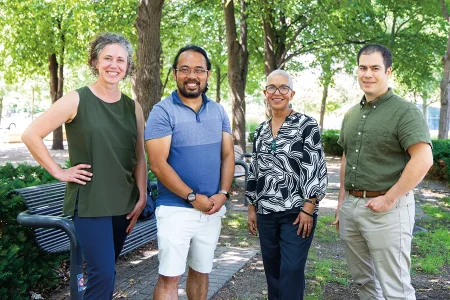At Centro Tyrone Guzman, a Minneapolis organization that provides culturally centered health and wellness programming, Latine families create Spanish-language videos documenting their progress toward healthier eating. Primary care clinics associated with Children’s Minnesota will then share these authentic stories with families — often with similar cultural backgrounds — to support healthy approaches to eating across a community who suffers from the highest childhood obesity rates in the country.
Spearheaded by SPH nutrition researchers, Centro’s work fills an urgent need across the state.
“Many primary care clinics serve diverse populations, but the clinicians do not always have staff who share the backgrounds and languages of the communities they serve,” says Melissa Laska, Distinguished McKnight University Professor and co-director of the Healthy Weight Research Center. “We hope this will be an effective model that clinicians can use to reach the Latine community and then adapt for other racial and ethnic groups and populations.”
The innovative partnership among SPH, Centro Tyrone Guzman, and Children’s Minnesota is one example of how the school has advanced both the study of nutrition and the effectiveness of nutrition interventions. For decades, nutrition research primarily focused on macronutrients like carbohydrates, proteins, and fats, and in far too many cases, limited participants to white, adult populations.
Today, researchers view diet and health through a much wider and nuanced lens, investigating how factors like mental health, diverse cultural backgrounds, and environmental factors can affect nutrition. And much of the school’s work now focuses on communities traditionally excluded — including young people, immigrant communities, and people experiencing food insecurity.
Laying the Foundation for Nutrition Research
Some of the earliest work on nutrition at SPH helped scientists understand the mental and physical effects of calorie restriction, laid the foundation for the field of cardiovascular epidemiology, and introduced the Mediterranean diet — which puts fruits, vegetables, legumes, and plant-based fats at the center of daily food intake — to a nation long used to a meat-and-potatoes diet.
As revolutionary as these early studies were, they were also a product of their time. For one, they were conducted solely on men, and almost exclusively on white men.
SPH Professor Ancel Keys spearheaded many of these studies. Keys launched the Minnesota Starvation Experiment in 1944 where young, male conscientious objectors were exposed to prolonged malnourishment. The experiment was designed to guide health professionals on how to best rehabilitate famine victims in Europe and Asia at the end of World War II. The study provided a valuable understanding of the mental and physical effects of starvation, though it’s often criticized as unethical.
Beginning in the 1950s, Keys also conceived of and led the Seven Countries study — credited as the first major multi-country epidemiological study. By analyzing the relationship among diet, lifestyle, heart disease, and stroke in middle-aged men, the study provided much of the initial research for the field of cardiovascular epidemiology. The researchers also concluded that the Mediterranean diet was consistently linked to a lower risk of cardiovascular events, and it remains the basis upon which all proven heart-healthy diets are built.
Moving Beyond One Size Fits All
Research that focuses on one population is a problem for obvious reasons — the human experience is not homogenous. In the decades since the Keys’ studies, SPH nutrition researchers have shifted to working with previously ignored or under- represented populations — women and girls, people of color, LGBTQIA+ people, immigrants, and economically disadvantaged groups.
Nutritional studies have also shifted to include community input into both the issues researched and how to tackle them. This new collaborative approach to research leads to more authentic problem solving, intervention development, and studies designed to meet the unique needs of diverse communities.
Today, researchers view diet and health through a much wider and nuanced lens, investigating how factors like mental health, diverse cultural backgrounds, and environmental factors can affect nutrition.

Tying research and training to a community-first approach means learning “from the practitioners and the community partners that we’re walking hand-in-hand with,” Laska says. “That’s such an important piece of trying to do right by these communities. The more we’ve shed light on health inequities and the need to focus on resolving health equity, the more our work has really shifted in that direction.”
Project EAT (Eating and Activity over Time), for example, was one of the first research projects to focus specifically on body image issues and eating habits among young people. The program has been essential in identifying disordered eating behaviors and body image concerns among young people of all shapes and sizes, from diverse gender, ethnic, racial, and socioeconomic backgrounds.
Regents Professor Dianne Neumark-Sztainer applied for funding for Project EAT shortly after she came to SPH and established the project in 1997. At that time, adolescents were not a priority group in nutritional behavior research. Her study demonstrated the importance of identifying and addressing risk and protective factors for nutrition, weight, and activity-related research early on in a person’s life. Today Neumark-Sztainer and other Project EAT researchers are studying how factors other than just age affect adolescents’ disordered eating.
“We’re interested in learning more about the social forces of racism, food insecurity, poverty, and weight stigma and how those work together to influence young people,” Neumark-Sztainer says.
Project EAT’s findings have led to concrete changes. Now in its 27th year, the project’s findings have been used in more than 500 published interventions, including studies on body satisfaction, weight teasing, and mental health, which researchers now recognize as connected to nutritional health.
“Today, researchers view diet and health through a much wider and nuanced lens, investigating how factors like mental health, diverse cultural backgrounds, and environmental factors can affect nutrition.”
Nutrition and Mental Health
Assistant Professor Katherine Hendel recently led an initiative using nutrition, physical activity, and social-emotional learning (how to interact with people) to promote overall health for middle school students in a suburban Twin Cities school district.
The tiered mentoring program, called Discover U, trains college students to mentor high school students who, in turn, work with middle school students. The project began in schools as students were returning from the pandemic.
Because of the Discover U project, researchers learned that kids’ mental health is suffering right now, and mental health needs to be at the top of the list of problems to be addressed in a follow-up project. Hendel is using her research findings to work on improving youth mental health with a new grant from the National Institute on Minority Health and Health Disparities. While the full scope of the project is still in development, one component will be a pilot trial of ways to improve physical activity and nutrition, along with symptoms of depression and anxiety among students at two racially and ethnically diverse middle schools.
The project builds on the SPH’s rich history of working with public schools. “So much of our health is influenced by our environments and the structures in our systems, and school has a lot to do with those environments for kids,” Hendel says. “How do we make the places where students and kids are going to be more supportive of their health?”
That is a critical question as childhood obesity is a growing problem in the U.S. According to the Centers for Disease Control and Prevention, 19.7% of children and adolescents aged 2 to 19 were considered obese between 2017 to 2020 — a rough equivalent of 14.7 million people. The issue is even more dire for Hispanic youth — 26.2% were found to obese in the same report.
Culturally-engaged projects like the one with Centro Tyrone Guzman to promote nutritional health in the Latine community are critical to successfully tackling nutritional issues at the population level.
Culturally Responsive Nutrition
To figure out how healthy or unhealthy a group’s diet is, researchers need to have an understanding of what makes up their diet. Since 1974, the School of Public Health’s Nutrition Coordinating Center (NCC) has been making much of this work possible. The NCC’s flagship tool is its dietary analysis software Nutrition Data System for Research (NDSR), and its associated database that contains comprehensive nutrient data for more than 19,500 foods. Over the center’s 50-year history, the variety of foods in the database has continually expanded with an eye toward ensuring foods from a wide array of eating traditions are included. For example, in recent years effort has been focused on adding more foods unique to the eating traditions of Somalia, Nigeria, Jamaica, Haiti, Korea, and Brazil. NDSR is a critical tool used by more than 100 institutions, ranging from Johns Hopkins University to NASA.

“We’re interested in learning more about the social forces of racism, food insecurity, poverty, and weight stigma and how those work together to influence young people.”
Dianne Neumark-Sztainer
“The extensive variety of the foods we include is a unique aspect of our database and NDSR is key to enabling nutrition research that encompasses all eating habits, and addresses health and nutrition inequities,” says NCC Director and Professor Lisa Harnack.
Preparing for the Future
At SPH, the same faculty who are advancing nutritional research are also training the next generation of leaders, and when it comes to health equity, there’s still considerable work to be done.
“When I talk with students, I always say that our Public Health Nutrition Master of Public Health (MPH) program trains the people who go out and create healthy environments,” says Jamie Stang, professor and public health nutrition program coordinator. “We’re population based, so we’re really looking at making sure everything we do is inclusive of race, ethnicity, gender, geography, and socioeconomic level — all the different aspects that make up the U.S. population with a focus on how policies, systems, and environments can have an impact on health.”
Since its founding in 1964, the public health nutrition program has graduated over a thousand students. The program offers two tracks: a traditional MPH program and a coordinated track where students earn an MPH while training to become registered dietitians. Students inthe traditional program do at least 120 hours of applied nutritional work, while those in the coordinated track complete at least 1,000 hours in various rotations, including a food pantry, a school cafeteria, and a clinical setting.
Both options prioritize hands-on experience and collaborating directly with communities. For example, public health nutrition students worked alongside African immigrants who wanted to create their own food systems in Minnesota by growing produce and raising halal animals. The students held listening sessions to learn what the community needs in order to support the creation of a self-sustaining system.
“A lot of our work is bridging the gap between taking the evidence and listening to the community and then figuring out how to make happen what the community wants,” Stang says.
That philosophy of community engagement continues in the Minnesota Obesity Prevention Fellowship which allows doctoral and postdoctoral researchers the opportunity to join with faculty on research projects focusing on obesity treatment and prevention.
One of them is Patrick Brady, a postdoctoral researcher who studies how to get more emergency foods to older adults living in rural, economically depressed communities.
Brady partnered with food shelves in Fairmont, a majority white community, and in Bemidji, which is near Tribal communities. He wanted to understand how increased federal funding for food during COVID affected both food shelves and people’s food security, and what’s changed since that funding ended.
Brady found that the funds helped, but once the funding ended, the food shelves saw more need for their services as communities faced higher costs at the grocery store.
“It was really this unfortunate timing of events where need at the food shelf level was going up while federal support was going down,” he says. Brady is now working on an individual training grant that will allow him to continue the work he started and help him eventually test solutions.
Eighty years ago, white men were the center of studies across many disciplines, and SPH nutrition research was no different. Even with that limited participant group, the school’s research in the few decades after its founding made vital discoveries, such as the link among diet, lifestyle, and cardiovascular health through the Seven Countries Study. Over time, nutrition research gradually widened its scope. Now the school is a full-on powerhouse in training, research, and outreach in public health nutrition and a leader in understanding how our environments, mental health, and physical activity are intimately related to nutritional health. Its research also serves as a reflection of the school’s overall commitment to supporting and partnering with communities, combating health inequities, and making health accessible to all populations.



